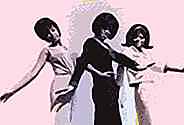


|
THE GIRL GROUPS SOUND OF THE 60S |
|---|
 |
 |
 |
|---|
|
|
 Spectropop's Introduction to the Girl Groups
Spectropop's Introduction to the Girl Groups
Although the 50s had its one-hit girl groups such as the Chantels, and the Bobbettes,, the peak period of what today is called "girl group music" occurred in the pre-British Invasion 1960s and was captained by the Brill Building writers and producers. Just a few of the girl groups include the Shirelles, the Chiffons, The Shangri-Las, The Dixie Cups, the Crystals, the Ronettes, the Angels, Reparata and the Delrons, the Exciters, the Cookies, the Supremes and the Velvelettes, The Shirelles can arguably be called the seminal girl group of the 60s. They made a minor hit and a major recording of their own composition "I Met Him On A Sunday". This was followed with a long string of hitsincluding "Tonight's The Night,". "Will You Love Me Tomorrow" and "Soldier Boy". The essence of what became to be known as the girl group sound was evident in these early Shirelles records. Although girl group sound was highly theatrical and influenced by records from the Leiber & Stoller school, the productions, arrangements and recordings were becoming more and more textured and full. The songs recorded by the girl groups were naive and adolescent, but like the times, the lyrics started to show a yearning for a better way of life. Indeed, the lyrics were unsophisticated and simple on the surface, but the subtext was there for every teenager to consider. Brill Building writers took a lot of flak for being superficial, but given the times, the simple yet yearning characteristics of lyrics on girl group records reflected all those adolescent problems from a female viewpoint. After the Shirelles initial success, a myriad of girl group records was released by major and indie labels, made by established and aspiring producers. Most famous of course was Phil Spector, who after having a #1 hit record with the Teddy Bears when he was still in high school had worked in New York with Leiber & Stoller. Among his girl group productions is the early "I Love How You Love Me" by the Paris Sisters on Gregmark. Shortly thereafter Spector signed the Crystals and began the Philles label, which could be called the pinnacle of the girl group labels. Meanwhile, many others were making girl group records, notably The Angels and The Chiffons. The Angels made records under the direction of songwriter/producers Bob Feldman, Jerry Goldstein, and Richard Gottehrer. The Chiffons, who had one of the greatest girl group records ever with "He's So Fine," were produced by the Tokens. 1963 also saw Spector reach the pinnacle of his career, with the Ronettes. Spector co-wrote and produced the a string of classics with the Ronettes such as Be My Baby," "Baby I Love You" and "Walking In The Rain." Perhaps the most successful label to mine the market for girl group records was. Leiber & Stoller's Red Bird Records. Bringing Brill writers Jeff Barry and Ellie Greenwich on board specifically to explore the genre, Red Bird enjoyed immediate hit success with The Dixie Cups' #1 "Chapel Of Love", a song Spector had recorded more than once but had never released. But Red Bird's coup was The Shangri-las, produced by George 'Shadow' Morton whom Ellie Greenwich had brought to Leiber & Stoller's attention. The Shangri-las records have often been described as comically over-dramatic, but records like "Remember (Walking In The Sand)", "Leader Of The Pack," "Past, Present And Future" and "I Can Never Go Home Anymore" have stood the test of time and are considered among the greatest records of the genre. Fantastic three-minute melodramas of teenage life in the mid-sixties, these were.
After The Shangri-las, the girl group era sadly died out, giving way to the British Invasion groups and their American counterparts. Ironically, these early British Invasion groups worshipped the girl groups, covering many of their hits on their early records and reintroducing the sound to a younger generation who for whatever reason had missed them the first time around. The Searchers' Needles and Pins, the Beatles' Chains, The Moody Blues' Go Now...all were originally records by U.S. girl groups.
|
|
|
 Girl Groups - A Short History
Girl Groups - A Short History
In the late 1950s, a number of female vocal groups began to produce songs that mixed doo wop harmonies with rhythm and blues music. The groups were usually trios or quartets in which one vocalist sang a lead part while the others contributed a background vocal. This arrangement became known as the "girl group" sound, and it flourished during the early 1960s. Girl groups were a constant presence on the Billboard pop charts in 1962 to 1965, but, by 1965 the popularity of this sound was waning as it was eclipsed by other musical trends. Although girl groups were only successful for a short time, their sound influenced many of their musical contemporaries, and it continues to have an impact on performers today >>>presented by History Of Rock |
 |